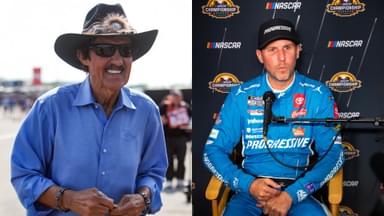Richard Petty, nicknamed ‘the King,” is known to the world as one of the greatest motorsports athletes of all time, a seven-time NASCAR Cup Series champion. However, not so many people know he led a group of drivers to advocate for driver safety during a key period in NASCAR’s history.
Advertisement
“All the drivers and stuff got together and said, ‘We’re not going to do this. I mean, we risk our lives enough,” Petty recalled in an interview with NASCAR.
Petty’s group, known as the Professional Drivers Association (PDA), was set up in August 1969. It had a slew of concerns, from driver safety and payouts to grueling schedules. Back then, the Grand National Series had 54 race weekends a year, an unthinkable workload by today’s standards.
Just a month after its founding, the PDA was at the center of a major boycott of the inaugural race at the iconic Talladega Superspeedway, the longest oval track in the NASCAR Cup Series and one of the fastest. The track’s reputation for speed and unpredictability attracts both fans and drivers. Races often culminate in dramatic finishes and sometimes multi-car crashes, famously called the “Big Ones.”
But the question remains: how did tensions escalate to the point 55 years ago where drivers felt compelled to boycott one of NASCAR’s most anticipated events?
The problems began during practice and qualifying sessions for the Talladega 500, the first major race scheduled at the new superspeedway. Many drivers voiced concerns that the track surface was too rough and dangerous. The track was built with a 33-degree bank on an old airfield.
Tires could not handle the speeds, which could approach 200 mph, leaving the drivers vulnerable to tire blowouts and crashes. Goodyear, the tire supplier, struggled to develop a compound that could withstand the track conditions.
With a prominent figure like Petty as president, drivers knew their voices would be heard. However, the France family, which ran NASCAR, dug in its heels. Talks between both parties began after the PDA’s launch but no headway was made. Faced with the impasse, the group decided to take drastic steps to force NASCAR to heed their demands.
The first major move came in the first week of September of that year at the Southern 500 weekend at the Darlington Raceway. Petty and the PDA held multiple meetings to get more drivers to join the organization.
By the time the Talladega weekend rolled around on September 14, more than two dozen drivers refused to participate in the race. “When we know we got a problem, then we’re not gonna do it,” Petty said, talking about the standoff…
Facing a driver shortage, Bill France Sr., who founded NASCAR was forced to act quickly. He filled the starting grid by bringing in Grand Touring cars and amateur drivers from a race held earlier. This allowed the Talladega 500 to go on.
But the absence of top NASCAR drivers made it a race unlike any other in NASCAR history. It also sent a strong message about the importance of driver safety in the sport.
Recent disputes between NASCAR and competitors, such as this year’s disagreement over revenue-sharing and a new charter agreement, focus on team owners. But back in 1969, it was the drivers themselves pushing back.
The PDA was dissolved by 1972 amid internal discord over the group’s direction and focus.
But both the group and Petty will be remembered for their bold stand at one of NASCAR’s most legendary tracks and their efforts in promoting safety brought results. While some changes took time to implement, the PDA’s actions in 1969 were key to getting NASCAR to revamp its driver safety practices.
This included improving car designs, such as introducing safety features like the Head and Neck Support (HANS) device which helps protect the head and neck in crashes. NASCAR also improved track safety by adding the SAFER – Steel And Foam Energy Reduction – barrier, which absorbs impact during crashes and reduces injury severity.
While the brutal racing schedule persisted for many years with drivers competing nearly every weekend, NASCAR eventually began paying more attention to driver fatigue and adjusted the number of races and length of the season.
The PDA’s existence may have been short-lived, but its influence on the sport’s safety regulations continues to reverberate even today.





